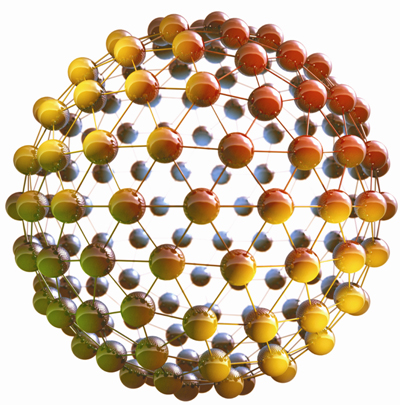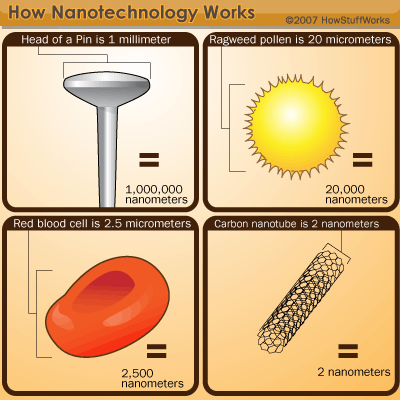NanoMaterials - a Definition
Nanomaterials are chemical substances or materials that are manufactured and used at a very small scale (down to 10,000 times smaller than the diameter of a human hair). Nanomaterials are developed to exhibit novel characteristics (such as increased strength, chemical reactivity or conductivity) compared to the same material without nanoscale features. Hundreds of products containing nanomaterials are already in use. Examples are batteries, coatings, anti-bacterial clothing etc. Analysts expect markets to grow to hundreds of billions of Euros by 2015. Nano innovation will be seen in many sectors including public health, information society, industry, innovation, environment, energy, transport, security and space
 Nano Material - Safe Clothing Limits Sports Injuries
Nano Material - Safe Clothing Limits Sports Injuries
Good things come in small packages. the unique properties of nanomaterials and structures on the nanometer scale have sparked the attention of materials developers. Incremental shifts in product performance using these materials-for example, as fillers in plastics, as coatings on surfaces, and as UV-protectants in cosmetics-are already occurring. The technology holds more promise for the future, though, and is expected to bring more disruptive changes to both products and markets.
Nanomaterials Main Fields
Nanomaterials is a field that takes a materials science-based approach to nanotechnology. It studies materials with morphological features on the nanoscale, and especially those that have special properties stemming from their nanoscale dimensions. Nanoscale is usually defined as smaller than a one tenth of a micrometer in at least one dimension, though this term is sometimes also used for materials smaller than one micrometer.
In comparison to a human hair which is ca. 80,000 nm in diameter, the nanofibers are 1,000 times smaller in diameter. When the characteristic length scale of the microstructure is in the 1- 100 nm range, it becomes comparable with the critical length scales of physical phenomena, resulting in the so-called “size and shape effects.” This leads to unique properties and the opportunity to use such nanostructured materials in novel applications and devices. Phenomena occurring on this length scale are of interest to physicists, chemists, biologists, electrical and mechanical engineers, and computer scientists, making research in nanotechnology a frontier activity in materials science.
The chemical processing and synthesis of high performance technological components for the private, industrial and military sectors requires the use of high purity ceramics, polymers, glass-ceramics and material composites.
In condensed bodies formed from fine powders, the irregular sizes and shapes of nanoparticles in a typical powder often lead to non-uniform packing morphologies that result in packing density variations in the powder compact.
Nanomaterials can be metals, ceramics, polymeric materials, or composite materials. Their defining characteristic is a very small feature size in the range of 1-100 nanometers (nm). At the nanomaterial level, some material properties are affected by the laws of atomic physics, rather than behaving as traditional bulk materials do.
In the mid-1980s a new class of material - hollow carbon spheres - was discovered. The way a crack grows in a larger-scale, bulk material is likely to be different from crack propagation in a nanomaterial where crack and particle size are comparable. Where proteins are 10-1000 nm in size, and cell walls 1-100 nm thick, their behavior on encountering a nanomaterial may be quite different from that seen in relation to larger-scale materials.
In bulk materials, only a relatively small percentage of atoms will be at or near a surface or interface (like a crystal grain boundary). In nanomaterials, the small feature size ensures that many atoms, perhaps half or more in some cases, will be near interfaces.
Surface properties such as energy levels, electronic structure, and reactivity can be quite different from interior states, and give rise to quite different material properties.
Let us examine in particular nanocomposites based on polymeric materials, keeping in mind that this is but one small division of nanomaterials. Those most humble of materials, clays, have been found to impart amazing properties.
Decrease in material flammability has also been studied, an especially important property for transportation applications where choice of material is influenced by safety concerns. Clay/polymer nanocomposites have been considered as matrix materials for fiber-based composites destined for aerospace components.
Some pores and other structural defects associated with density variations have been shown to play a detrimental role in the sintering process by growing and thus limiting end-point densities.
The containment of a uniformly dispersed assembly of strongly interacting particles in suspension requires total control over particle-particle interactions.
Monodisperse powders of colloidal silica, for example, may therefore be stabilized sufficiently to ensure a high degree of order in the colloidal crystal orpolycrystalline colloidal solid which results from aggregation. On 18 October 2011, the European Commission adopted the following definition of a nanomaterial : A natural, incidental or manufactured material containing particles, in an unbound state or as an aggregate or as an agglomerate and where, for 50% or more of the particles in the number size distribution, one or more external dimensions is in the size range 1 nm – 100 nm.
In specific cases and where warranted by concerns for the environment, health, safety or competitiveness the number size distribution threshold of 50% may be replaced by a threshold between 1 and 50%.
An important aspect of nanotechnology is the vastly increased ratio of surface area to volume present in many nanoscale materials, which makes possible new quantum mechanical effects. One example is the “quantum size effect” where the electronic properties of solids are altered with great reductions in particle size.
This effect does not come into play by going from macro to micro dimensions. However, it becomes pronounced when the nanometer size range is reached. A certain number of physical properties also alter with the change from macroscopic systems.
Novel mechanical properties of nanomaterials is a subject of nanomechanics research. Catalytic activities also reveal new behaviour in the interaction with biomaterials. The most energetic research probably concerns carbon nanotubes. Nanoparticles of carbon - rods, fibers, tubes with single walls or double walls, open or closed ends, and straight or spiral forms - have been synthesized in the past 10 years.
There is good reason to devote so much effort to them: carbon nanotubes have been shown to have unique properties, stiffness and strength higher than any other material, for example, as well as extraordinary electronic properties. Carbon nanotubes are reported to be thermally stable in vacuum up to 2800 degrees Centigrade, to have a capacity to carry an electric current a thousand times better than copper wires, and to have twice the thermal conductivity of diamond (which is also a form of carbon). Carbon nanotubes are used as reinforcing particles in nanocomposites, but also have many other potential applications. They could be the basis for a new era of electronic devices smaller and more powerful than any previously envisioned. Nanocomputers based on carbon nanotubes have already been demonstrated.
You might also like
| Nanomaterials - the Future Technology Nanomaterials - Applications for Nanotechnology Nanomaterials... | What is Nanotechnology? Nanotechnology and Applications Nanotechnology... | Nanotechnology in Food Could nanotechnology make a food? Nanotechnology... | Impact of Nanotechnology Nanotechnology Impact The impact of nanotechnology... |




 Alloy Suppliers
Alloy Suppliers
 Aluminum
Aluminum
 Aluminum Extrusions
Aluminum Extrusions
 Copper-Brass-Bronze
Copper-Brass-Bronze
 Nickel
Nickel
 Magnets
Magnets
 Stainless Steel
Stainless Steel
 Stainless Steel Tubing
Stainless Steel Tubing
 Steel Service Centers
Steel Service Centers
 Titanium
Titanium
 Tungsten
Tungsten
 Wire Rope
Wire Rope